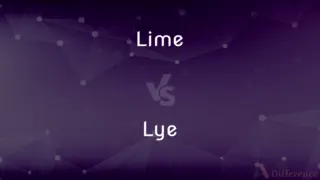Silicon vs. Silicone — What's the Difference?
Edited by Tayyaba Rehman — By Fiza Rafique — Updated on October 1, 2023
Silicon is a natural chemical element used in electronics, while Silicone is a synthetic material made from silicon, carbon, hydrogen, and oxygen.
Difference Between Silicon and Silicone
Table of Contents
ADVERTISEMENT
Key Differences
In conclusion, while Silicon is a fundamental element that plays a pivotal role in electronics and construction, Silicone is a flexible and durable synthetic material used across multiple industries for various purposes. Despite their phonetic similarities, their compositions and uses set them apart distinctly.
Fiza Rafique
Oct 01, 2023
Silicon and Silicone, despite having similar names, represent vastly different materials. Silicon, a naturally occurring chemical element, is found in abundance in the Earth's crust. This semi-metallic element has impressive conductive properties, making it a prime choice in the electronics and computer industries.
Fiza Rafique
Oct 01, 2023
Silicon, with its crystal lattice structure, forms the base for quartz and is a primary ingredient in many types of rocks and sands. This makes it an essential material in the construction industry, especially for making concrete and glass. Silicone, given its versatility, finds its way into sealants, lubricants, and cosmetic surgeries, emphasizing its adaptability in various applications.
Fiza Rafique
Oct 01, 2023
On the other hand, Silicone is a synthetic compound derived from silicon and other elements such as carbon, hydrogen, and oxygen. It's recognized for its flexibility, resistance to heat and moisture, and its insulating properties. Due to these characteristics, Silicone is widely used in various industries, from cookware to medical implants.
Fiza Rafique
Oct 01, 2023
Comparison Chart
ADVERTISEMENT
Composition
Single element
Combination of silicon, carbon, hydrogen, and oxygen
Fiza Rafique
Oct 01, 2023
Definitions
Silicon
A chemical element with symbol Si.
Silicon is essential for making semiconductors.
Fiza Rafique
Oct 01, 2023
ADVERTISEMENT
Silicone
A synthetic polymer.
Silicone is used in baking mats because it's non-stick and heat-resistant.
Fiza Rafique
Oct 01, 2023
Silicon
Found abundantly in Earth's crust.
Sand is a primary source of silicon.
Fiza Rafique
Oct 01, 2023
Silicone
Acts as an effective sealant.
Silicone sealants are used to prevent leaks in bathrooms.
Fiza Rafique
Oct 01, 2023
Silicon
Used in electronics for its conductive properties.
Silicon wafers form the basis of most computer chips.
Fiza Rafique
Oct 01, 2023
Silicone
Derived from silicon and other elements.
Silicone contains silicon, carbon, hydrogen, and oxygen.
Fiza Rafique
Oct 01, 2023
Silicon
Forms the base of quartz.
Quartz, made mostly of silicon, is used in various jewelry.
Fiza Rafique
Oct 01, 2023
Silicone
Used in medical and cosmetic applications.
Silicone is often used in breast implants.
Fiza Rafique
Oct 01, 2023
Silicon
Hard and brittle in its crystalline form.
In its natural state, silicon can be quite rigid.
Fiza Rafique
Oct 01, 2023
Silicone
Notably heat-resistant and rubbery.
Silicone spatulas can withstand high cooking temperatures.
Fiza Rafique
Oct 01, 2023
Silicon
Silicon is a chemical element with the symbol Si and atomic number 14. It is a hard, brittle crystalline solid with a blue-grey metallic lustre, and is a tetravalent metalloid and semiconductor.
Fiza Rafique
Feb 24, 2020
Silicone
A silicone or polysiloxane is a polymer made up of siloxane (−R2Si−O−SiR2−, where R = organic group). They are typically colorless, oils or rubber-like substances.
Fiza Rafique
Feb 24, 2020
Silicon
A nonmetallic element occurring extensively in the earth's crust in silica and silicates, having both a brown amorphous and a gray lustrous crystalline allotrope, and used doped or in combination with other materials in glass, semiconducting devices, concrete, brick, refractories, pottery, and silicones. Atomic number 14; atomic weight 28.086; melting point 1,414°C; boiling point 3,265°C; specific gravity 2.33 (25°C); valence 2, 4. See Periodic Table.
Fiza Rafique
Feb 24, 2020
Silicone
Any of a class of synthetic materials which are polymers with a chemical structure based on chains of alternate silicon and oxygen atoms, with organic groups attached to the silicon atoms. Such compounds are typically resistant to chemical attack and insensitive to temperature changes and are used to make rubber and plastics and in polishes and lubricants
Silicone rubber
Modern plastics and silicones
Fiza Rafique
Feb 24, 2020
Silicon
A nonmetallic element (symbol Si) with an atomic number of 14 and atomic weight of 28.0855.
Fiza Rafique
Feb 24, 2020
Silicone
Join or otherwise treat (something) with a silicone
The raised planting shelf could be siliconed to the back of the tank
Fiza Rafique
Feb 24, 2020
Silicone
Any of a large group of oligomers and polymers based on the structural unit R2SiO, where R is an organic group, characterized by wide-range thermal stability, high lubricity, extreme water repellence, and physiological inertness and used in adhesives, lubricants, protective coatings, paints, electrical insulation, synthetic rubber, and prosthetic replacements for body parts.
Fiza Rafique
Feb 24, 2020
Silicone
(chemistry) Any of a class of inert, semi-inorganic polymeric compounds (polysiloxanes), that have a wide range of thermal stability and extreme water repellence, used in a very wide range of industrial applications, and in prosthetic replacements for body parts.
Fiza Rafique
Feb 24, 2020
Silicone
(transitive) To join or treat (something) with a silicone-based product.
Silicone the bathtub to the tile
Fiza Rafique
Feb 24, 2020
Silicone
To enhance or reconstruct (a body part) with a prosthesis containing silicone.
Fiza Rafique
Feb 24, 2020
Silicon
A nonmetalic element analogous to carbon. It always occurs combined in nature, and is artificially obtained in the free state, usually as a dark brown amorphous powder, or as a dark crystalline substance with a meetallic luster. Its oxide is silica, or common quartz, and in this form, or as silicates, it is, next to oxygen, the most abundant element of the earth's crust. Silicon is characteristically the element of the mineral kingdom, as carbon is of the organic world. Symbol Si. Atomic weight 28. Called also silicium.
Fiza Rafique
Feb 24, 2020
Silicone
Any of a large class of siloxanes that are unusually stable over a wide range of temperatures; used in lubricants and adhesives and coatings and synthetic rubber and electrical insulation
Fiza Rafique
Feb 24, 2020
Silicon
A tetravalent nonmetallic element; next to oxygen it is the most abundant element in the earth's crust; occurs in clay and feldspar and granite and quartz and sand; used as a semiconductor in transistors
Fiza Rafique
Feb 24, 2020
FAQs
What is Silicon primarily used for?
Silicon is primarily used in the electronics industry for making semiconductors.
Fiza Rafique
Oct 01, 2023
Is Silicone a natural material?
No, Silicone is a synthetic compound derived from silicon and other elements.
Fiza Rafique
Oct 01, 2023
Why is Silicone used in cookware?
Silicone is heat-resistant, flexible, and non-stick, making it ideal for cookware.
Fiza Rafique
Oct 01, 2023
Can Silicon conduct electricity?
Yes, Silicon is a semiconductor and can conduct electricity under certain conditions.
Fiza Rafique
Oct 01, 2023
Is Silicone safe for medical implants?
Yes, medical-grade Silicone is considered safe for implants and various medical applications.
Fiza Rafique
Oct 01, 2023
Are Silicone products eco-friendly?
While Silicone is durable and long-lasting, it's not biodegradable but can often be recycled.
Fiza Rafique
Oct 01, 2023
How is Silicon extracted?
Silicon is usually extracted from silica, found in sand, through a smelting process.
Fiza Rafique
Oct 01, 2023
How does Silicon differ from other metals in conductivity?
Silicon is a semiconductor, meaning its conductivity can be altered and controlled, unlike typical metals.
Fiza Rafique
Oct 01, 2023
Can Silicon exist in a liquid state?
Yes, Silicon can be melted at high temperatures exceeding 2,500°F (1,410°C).
Fiza Rafique
Oct 01, 2023
Can Silicone be painted over?
It's challenging to paint over Silicone directly; surfaces often need priming first.
Fiza Rafique
Oct 01, 2023
Is Silicon found in our bodies?
Trace amounts of Silicon are found in human tissues, and it's considered essential for bone growth.
Fiza Rafique
Oct 01, 2023
What makes Silicone suitable for sealants?
Silicone is water-resistant and adheres well to various surfaces, making it an effective sealant.
Fiza Rafique
Oct 01, 2023
Author Spotlight
Written by
Fiza RafiqueFiza Rafique is a skilled content editor at AskDifference.com, where she meticulously refines and enhances written pieces. Drawing from her vast editorial expertise, Fiza ensures clarity, accuracy, and precision in every article. Passionate about language, she continually seeks to elevate the quality of content for readers worldwide.
Edited by
Tayyaba RehmanTayyaba Rehman is a distinguished writer, currently serving as a primary contributor to askdifference.com. As a researcher in semantics and etymology, Tayyaba's passion for the complexity of languages and their distinctions has found a perfect home on the platform. Tayyaba delves into the intricacies of language, distinguishing between commonly confused words and phrases, thereby providing clarity for readers worldwide.

















































